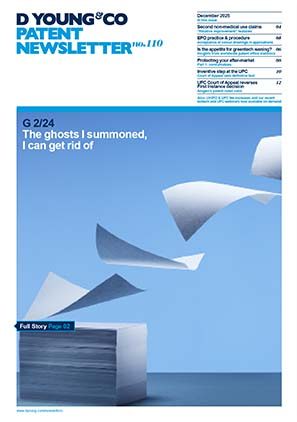UKIPO to appeal High Court decision: are AI inventions patentable?
In November 2023 the High Court, in Emotional Perception AI Ltd v Comptroller-General of Patents, Designs and Trade Marks [2023] EWHC 2948 (Ch), found that artificial neural networks (ANNs) should not be excluded from patent protection as “a program for a computer…as such”.
The UK Intellectual Property Office (UKIPO) has now updated the manual of patent practice to reflect this judgment. The new practice notes read, at section 1.39.4, that “[T]he High Court held that an ANN, whether implemented in hardware or software, was not a program for a computer, so the claimed invention involving a particular method of training and using an ANN did not invoke the computer program exclusion [under section 1(2) UPKA]. Nonetheless, the judge also considered whether the trained ANN was capable of being an external technical effect, and accepted that it is capable. This prevented the computer program exclusion from applying to the remainder of the invention. Following the Emotional Perception judgment, examiners should not use the program for a computer exclusion to object to inventions involving ANNs”.
This is a very welcome development given that AI is an increasingly significant area of innovation, both in terms of the AI systems themselves and also their applications; historically the UK has been seen as a more restrictive jurisdiction for such applications than the European Patent Office (EPO), despite their theoretical alignment, and this decision significantly rectifies that.
However, it has almost immediately been undermined by the UKIPO’s recent announcement that it has requested and has been granted leave to appeal the decision at the Court of Appeal.
Given the generally positive reception to the original judgment by most parties, the motivations for doing so are as yet unknown but will no doubt be made clear once the appeal commences. In the meantime, the new practice guidance remains in force and UKIPO examiners are applying it to examination.
With regard to the appeal, Sir Antony Mann’s reasoning in the High Court judgment seemed straightforward, and can be summarised as follows:
The statutory exclusion is to a program for a computer as such. This therefore obviously requires both a program, and a computer. The judge noted that for a hardware implementation of an artificial neural network, the artificial neural network may be treated as an (unconventional) computer, but when it operated there was no program as such because no person had given a set of instructions to the computer to do what it does; it is operating according to something that it has learned itself.
In the case of an emulated artificial neural network (software simulating the operation of an artificial neural network), the judge then said “I do not see why the same should not apply to the emulated ANN. It is not implementing code given to it by a human. The structure, in terms of the emulation of uneducated nodes and layers, may well be the result of programming, but that is just the equivalent of the hardware ANN. The actual operation of those nodes and layers inter se is not given to those elements by a human. It is created by the ANN itself...It seems to me that it is appropriate to look at the emulated ANN as, in substance, operating at a different level (albeit metaphorically) from the underlying software on the computer, and it is operating in the same way as the hardware ANN. If the latter is not operating a program then neither is the emulation.”
This position strongly echoes our own view as submitted in response to the 2020 UK Government consultation on AI in which D Young & Co’s attorneys argued:
“We also seek to distinguish AIs from computer programs as such. Again, a trained AI embodies an abstraction of data (for example, real-world training data) within its structure, and as such each AI may be considered a new and bespoke form of computer, whether implemented in hardware or emulated in software…At the very least, this should give cause for reconsideration of whether and how the current Symbian signposts are interpreted for AIs”. We also noted “[I]t is our position that an AI is any technology whose output or functionality is at least in part a consequence of training rather than programming…[and hence]…that AIs are a new and unique form of computing…and their interaction with the existing statutory exclusions should be treated…in a different manner to the approach taken with traditional computer programs”.
We hope that the Court of Appeal takes a similar view in due course, and will report on developments when the appeal begins.
Related articles
- UK High Court overrules UKIPO to find AI inventions patentable: dycip.com/ai-inventions-patentable
- AI (part one): how does AI interact with UK excluded subject matter provisions?: dycip.com/ai-excluded-subject-matter
Useful link
Manual of Patent Practice, UK Government: dycip.com/uk-gov-manual-patent-practice

